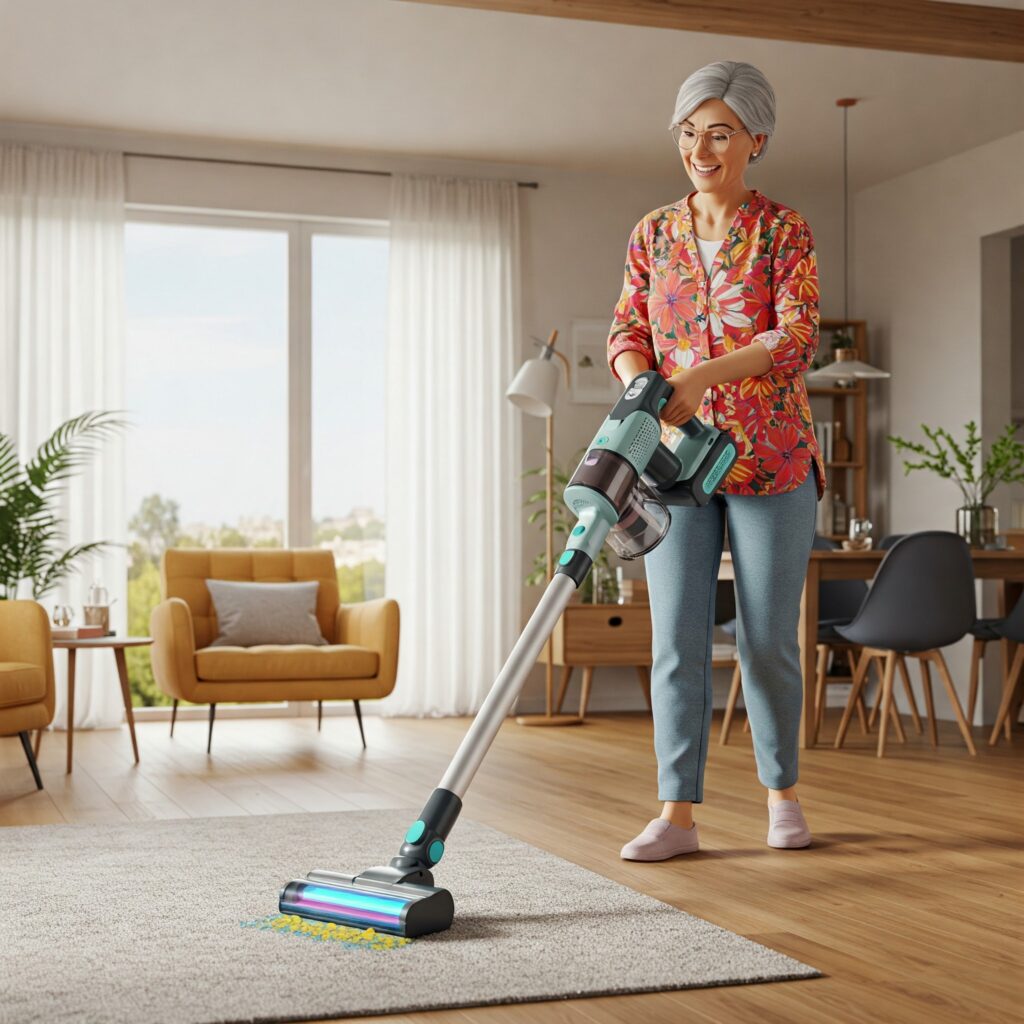Membersihkan rumah adalah kegiatan rutin yang penting untuk menjaga kesehatan dan kenyamanan. Salah satu alat yang sangat membantu dalam pekerjaan ini adalah vacuum cleaner. Dengan teknologi yang semakin maju, kini hadir vacuum cleaner cordless atau tanpa kabel yang menawarkan kemudahan dan fleksibilitas dalam membersihkan setiap sudut rumah.
Namun, dengan banyaknya pilihan yang tersedia, memilih vacuum cleaner cordless yang tepat bisa menjadi tantangan tersendiri. Terutama bagi Anda yang memiliki anggaran terbatas di bawah 1 juta rupiah. Jangan khawatir, artikel ini akan memberikan 10 rekomendasi vacuum cleaner cordless terbaik di bawah 1 juta rupiah yang bisa menjadi referensi Anda.
Mengapa Memilih Vacuum Cleaner Cordless?
Sebelum membahas rekomendasi produk, mari kita pahami terlebih dahulu mengapa vacuum cleaner cordless menjadi pilihan yang semakin populer:
H3: Keunggulan Vacuum Cleaner Cordless
- Tanpa Kabel yang Mengganggu: Keunggulan utama vacuum cleaner cordless adalah tidak adanya kabel yang membatasi ruang gerak. Anda bisa membersihkan seluruh ruangan dengan leluasa tanpa perlu mencari colokan listrik atau khawatir kabel tersangkut.
- Ringan dan Mudah Bermanuver: Vacuum cleaner cordless umumnya didesain ringan dan ergonomis, sehingga mudah dibawa dan digunakan untuk membersihkan area yang sulit dijangkau seperti tangga, langit-langit, atau interior mobil.
- Multifungsi: Banyak vacuum cleaner cordless yang dilengkapi dengan berbagai nozzle atau kepala penyedot yang dapat diganti sesuai kebutuhan. Mulai dari crevice tool untuk membersihkan celah sempit, brush nozzle untuk permukaan kain, hingga motorized brush untuk mengangkat debu dan bulu hewan peliharaan secara efektif.
- Praktis dan Efisien: Vacuum cleaner cordless sangat praktis digunakan untuk pembersihan cepat sehari-hari. Anda tidak perlu repot mengeluarkan dan merakit vacuum cleaner konvensional yang besar dan berat. Cukup ambil, nyalakan, dan bersihkan area yang diinginkan.
- Penyimpanan Ringkas: Ukurannya yang relatif kecil dan desain cordless membuat vacuum cleaner jenis ini mudah disimpan tanpa memakan banyak tempat. Beberapa model bahkan dilengkapi dengan docking station untuk pengisian daya dan penyimpanan aksesori.
10 Rekomendasi Vacuum Cleaner Cordless di Bawah 1 Juta Rupiah
Berikut adalah 10 rekomendasi vacuum cleaner cordless di bawah 1 juta rupiah yang menawarkan kombinasi terbaik antara harga, kualitas, dan fitur:
1. BOLDe Super Hoover Turbo
- Harga Terjangkau: BOLDe Super Hoover Turbo adalah salah satu vacuum cleaner cordless termurah di pasaran dengan harga sekitar Rp289.000.
- Desain Simpel dan Elegan: Desainnya yang simpel membuatnya mudah digunakan dan disimpan, namun tetap terlihat elegan dengan pilihan warna yang menarik.
- Filter Microparticle: Dilengkapi dengan filter microparticle yang efektif menyedot debu dan kotoran halus.
- Pilihan Warna Menarik: Tersedia dalam berbagai pilihan warna yang bisa disesuaikan dengan selera Anda.
- Cocok untuk: Penggunaan sehari-hari di rumah dengan kebutuhan pembersihan standar.
2. Deerma Vacuum Cleaner UV-C
- Harga di Bawah Setengah Juta: Deerma Vacuum Cleaner UV-C menawarkan fitur lengkap dengan harga yang sangat terjangkau.
- Sinar Ultraviolet: Dilengkapi dengan lampu ultraviolet yang dapat membasmi bakteri dan kuman, selain menyedot debu dan kotoran.
- Multifungsi: Dapat digunakan untuk membersihkan lantai, permukaan benda, hingga kasur dan sofa.
- Kecepatan Tinggi: Mampu menyedot debu dan kotoran dengan kecepatan yang cukup dapat diandalkan.
- Cocok untuk: Keluarga dengan anak kecil atau hewan peliharaan yang membutuhkan pembersihan ekstra higienis.
3. Denpoo HRV-8003 Vacuum Cleaner
- Harga Ekonomis: Denpoo HRV-8003 adalah pilihan vacuum cleaner cordless ekonomis dengan harga sekitar Rp320.000.
- Ringkas dan Ramping: Bentuknya yang ringkas dan ramping membuatnya mudah digunakan dan disimpan di ruang terbatas.
- Multifungsi: Diklaim mampu menyedot debu dan kotoran hingga ke sela-sela ruangan.
- Cocok untuk: Rumah dengan ruang terbatas atau apartemen studio.
4. Idealife IL-130 Mini Vacuum Cleaner
- Sangat Terjangkau: Idealife IL-130 Mini Vacuum Cleaner adalah vacuum cleaner cordless termurah dengan harga sekitar Rp450.000.
- Praktis dan Portabel: Ukurannya yang mini membuatnya sangat praktis dibawa bepergian atau disimpan di mobil.
- Menjangkau Debu di Lantai dan Benda: Dapat digunakan untuk membersihkan debu dan kotoran di lantai maupun permukaan benda.
- Cocok untuk: Penggunaan di mobil, kantor kecil, atau sebagai vacuum cleaner tambahan untuk area tertentu.
5. Kurumi KV 01
- Ukuran Mini dan Imut: Kurumi KV 01 memiliki desain yang sangat kecil dan imut, berbeda dengan vacuum cleaner pada umumnya.
- Efektif Menyedot Debu dan Serangga: Meskipun kecil, vacuum cleaner ini sangat efektif menyedot debu, kotoran, dan bahkan serangga kecil.
- Filter HEPA dan UV Vertical: Dilengkapi filter HEPA untuk menyaring polutan kecil dan UV vertical untuk membasmi tungau dan bakteri.
- Daya Hisap Tinggi: Memiliki daya hisap yang tinggi untuk membersihkan lantai dengan cepat.
- Cocok untuk: Membersihkan kasur, sofa, atau area yang membutuhkan pembersihan detail.
6. Maxhealth Cyclone Vacuum Cleaner
- Ukuran Kecil, Kekuatan Tinggi: Maxhealth Cyclone Vacuum Cleaner menawarkan kekuatan hisap yang tinggi meskipun ukurannya kecil.
- Penyaringan Debu dan Kotoran Efektif: Mampu menyedot dan menyaring debu dan kotoran dengan baik.
- Mudah Digunakan dan Disimpan: Ukurannya yang kecil membuatnya mudah digunakan dan tidak memakan banyak ruang penyimpanan.
- Cocok untuk: Rumah tangga yang mengutamakan kekuatan hisap dalam vacuum cleaner berukuran ringkas.
7. PerySmith X10 Lite Handheld Vacuum Cleaner Portable
- Fitur Dual HEPA Filter: PerySmith X10 Lite dilengkapi dengan dual HEPA filter yang memastikan udara yang keluar lebih bersih dan sehat.
- 2-in-1 Stick & Handheld: Dapat digunakan sebagai stick vacuum cleaner untuk lantai atau handheld vacuum cleaner untuk area yang lebih kecil.
- Ringan: Bobotnya hanya 1.1 kg, sangat ringan dan mudah digunakan.
- Daya Hisap Kuat: Memiliki daya hisap hingga 19.000 Pa.
- Cocok untuk: Pengguna yang mencari vacuum cleaner multifungsi dengan filtrasi udara yang baik.
8. Airbot Airbot Aura Cordless Vacuum Cleaner
- Pengisian Daya Magnetis: Dilengkapi dengan pengisian daya magnetis yang praktis dan cepat.
- 2-in-1 Stick & Handheld: Fleksibel digunakan sebagai stick maupun handheld vacuum cleaner.
- Waktu Pemakaian Lama: Mampu digunakan hingga 35 menit dalam sekali pengisian daya.
- Tingkat Kebisingan Rendah: Tingkat kebisingan hanya 60 dB, tidak mengganggu aktivitas di rumah.
- Berbagai Aksesori: Dilengkapi dengan berbagai aksesori seperti sikat lembut, sikat lantai bermotor, dan crevice tool.
- Cocok untuk: Rumah tangga yang membutuhkan vacuum cleaner dengan daya tahan baterai lama dan tingkat kebisingan rendah.
9. INSE Cordless Vacuum Cleaner
- Banyak Pilihan Nozzle: INSE Cordless Vacuum Cleaner menawarkan banyak pilihan nozzle untuk berbagai kebutuhan pembersihan.
- 2-in-1 Stick & Handheld: Dapat diubah menjadi stick atau handheld vacuum cleaner sesuai kebutuhan.
- Waktu Pemakaian Panjang: Mampu digunakan hingga 45 menit dalam sekali pengisian daya.
- Sistem Filtrasi Lima Lapis: Dilengkapi dengan sistem filtrasi lima lapis untuk menyaring debu dan alergen secara efektif.
- Kepala Sikat Fleksibel: Kepala sikat yang fleksibel memudahkan pembersihan area sulit dijangkau.
- Cocok untuk: Rumah dengan berbagai jenis permukaan yang membutuhkan vacuum cleaner serbaguna.
10. Lydsto Lydsto Cordless Vacuum Cleaner 19 kPa
- Lampu LED: Dilengkapi lampu LED di bagian depan untuk membantu membersihkan area gelap.
- 2-in-1 Stick & Handheld: Dapat digunakan sebagai stick maupun handheld vacuum cleaner.
- Daya Hisap Kuat: Memiliki daya hisap hingga 19.000 Pa.
- Pipa Teleskopik: Dilengkapi pipa teleskopik yang dapat disesuaikan panjangnya.
- Sikat Rol Otomatis: Memudahkan pembersihan berbagai jenis permukaan lantai.
- Cocok untuk: Pengguna yang membutuhkan vacuum cleaner dengan daya hisap kuat dan fitur tambahan seperti lampu LED.
Tips Memilih Vacuum Cleaner Cordless di Bawah 1 Juta Rupiah
Memilih vacuum cleaner cordless dengan budget terbatas memang membutuhkan pertimbangan yang cermat. Berikut adalah beberapa tips yang bisa Anda ikuti:
Perhatikan Daya Hisap
Daya hisap adalah faktor utama yang menentukan efektivitas vacuum cleaner. Semakin tinggi daya hisap (biasanya diukur dalam Pascal atau Pa), semakin kuat vacuum cleaner dalam mengangkat debu dan kotoran. Untuk penggunaan sehari-hari, daya hisap sekitar 8.000 Pa hingga 19.000 Pa sudah cukup memadai.
Pilih Jenis yang Tepat
Vacuum cleaner cordless hadir dalam beberapa jenis, seperti stick vacuum, handheld vacuum, dan 2-in-1 (stick dan handheld). Pilih jenis yang sesuai dengan kebutuhan dan preferensi Anda. Stick vacuum cocok untuk membersihkan lantai secara keseluruhan, handheld vacuum ideal untuk area kecil atau interior mobil, sedangkan 2-in-1 menawarkan fleksibilitas keduanya.
Pertimbangkan Kapasitas Baterai dan Waktu Pemakaian
Perhatikan kapasitas baterai dan waktu pemakaian vacuum cleaner. Kapasitas baterai yang besar akan memberikan waktu pemakaian yang lebih lama. Sesuaikan dengan luas rumah atau area yang ingin Anda bersihkan. Waktu pemakaian sekitar 20-45 menit umumnya cukup untuk penggunaan rumah tangga.
Fitur Tambahan yang Bermanfaat
Beberapa vacuum cleaner cordless dilengkapi dengan fitur tambahan yang bisa menjadi nilai lebih, seperti:
- Filter HEPA: Menyaring partikel debu halus dan alergen, baik untuk penderita alergi.
- Lampu LED: Memudahkan pembersihan area gelap.
- Sinar UV: Membasmi bakteri dan tungau.
- Berbagai Nozzle: Memudahkan pembersihan berbagai jenis permukaan dan area.
Bandingkan Harga dan Merek
Lakukan perbandingan harga dan merek dari berbagai vacuum cleaner cordless yang masuk dalam预算 Anda. Baca ulasan pengguna dan review produk untuk mendapatkan gambaran yang lebih jelas mengenai kualitas dan performa masing-masing merek dan model. Merek-merek seperti BOLDe, Deerma, PerySmith, dan INSE cukup populer di kelas harga di bawah 1 juta rupiah.
H2: Kesimpulan
Vacuum cleaner cordless di bawah 1 juta rupiah menawarkan solusi praktis dan efisien untuk menjaga kebersihan rumah tanpa harus menguras kantong. Dengan memilih produk yang tepat dan sesuai dengan kebutuhan, Anda bisa mendapatkan vacuum cleaner berkualitas yang akan menjadi andalan dalam membersihkan rumah sehari-hari.
Dari 10 rekomendasi di atas, Anda bisa memilih vacuum cleaner cordless yang paling sesuai dengan preferensi dan kebutuhan Anda. Pertimbangkan fitur, daya hisap, kapasitas baterai, dan tentu saja, budget yang Anda miliki. Selamat memilih dan semoga artikel ini bermanfaat!

Arya adalah representasi ideal dari penulis di SuaraGue: berpengetahuan, berwawasan, dan berdedikasi untuk menyajikan informasi media komunikasi terkini.



